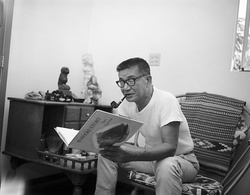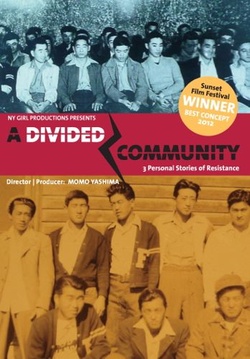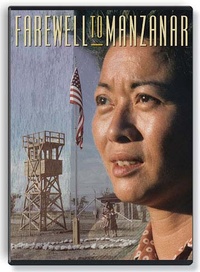I’ve never done anything like making a documentary but somehow I was able to visualize things in my head, capture it on film, and figure out how to edit it. I could see what I wanted—maybe because I had grown up with artwork all around me at home; maybe because I was invited to watch dailies with John Korty, the director of Farewell to Manzanar, while working on the film.
The subject of the camps made me angry. In my early research, I was perplexed that nobody stood up to fight this evacuation (E.O. 9066). In fact, there were close to 300 young men who DID! They went to court, were found guilty of draft evasion, and spent 2-4 years in Federal Penitentiaries!!! A Divided Community is the story of 3 of these men, known as the Resisters, telling their side of the story.
Do you know the writer Frank Chin? He had been talking about the Resisters ever since we were filming Farewell to Manzanar in 1974. I never saw anything about them in the books…I thought he was nuts. “Aww, you know Frank!” I thought. Many years later he called one day and said, “Momo, I need you to come to Chinatown and read something. You have to be the narrator of something I wrote.” “Okay,” I said, and was off to Chinatown. Frank was doing a reading at the old General Lee’s Restaurant. He shoved a script into my hands. With this, four old men, Frank and me, we told a tale of the Resisters. This was my introduction to them.
Frank has a certain style of writing that, although truthful, can be quite abrasive. We did this show several times at various venues. Then after one of the readings, Frank said, “Okay, Momo. I need you to take over this project.” WHAT?!!!! I knew nothing about the Resisters!
“YOU HAVE A GOOD FAMILY NAME, YOU COME FROM CLEAN ARTISTIC STOCK, AND THE JAPANESE COMMUNITY LIKES YOU. THEY REALLY HATE ME FOR THE THINGS I KEEP BRINGING UP. I’M NOT EVEN JAPANESE. I MAY BE A DETRIMENT TO THE PROJECT.”
I looked at the four men and said, “Can we have a meeting so we can talk about this, see whether you want to continue with me, and I can see if you’re interested in some ideas that I have.”
We kept a skeleton of Frank’s script but replaced a lot of it with personal stories:
Where were you when Pearl Harbor happened? How old were you? What were you doing? I wrote out what they told me and it became an hour-long presentation. We took it all over Southern California to Asian Studies Departments and got tremendous response because, again, no one had ever heard of this. I’m sure the kids were like me thinking, “FINALLY, here’s a story of someone not going with the flow, not being sheep, not going down that path. These were the guys that fought the right way: a way thought to be guaranteed fairness for citizen Americans—in court!”
Then JANM co-sponsored me and I was able to present 10 shows at the Democracy Forum. We bussed in high school students and they LOVED it! That’s when I knew I was sitting on a deliberately concealed episode in Nikkei wartime history. I then filmed the men telling their story, inter-cut with archival footage and photos from their scrapbooks. Things started to take shape and that’s the film, basically. It’s aimed at high school and college students.
Why the Resisters story resonated with me…
My family—my mother and father—were fine artists from Japan, but they were also activists as well. They were jailed many times in Japan for their anti-war stance and speaking out against the Imperial Army and what they did in Korea, China, and Manchuria. Because of the beatings they got while imprisoned, my mother lost a baby. Her father knew he had to get them out of the country or they’d be killed. Because he had a shipbuilding company, he had contacts all over the world. They knew the West Coast was not a good place for them (this was in the late 1930s) and that they had to get to the East Coast. My grandfather got them to New York City via the Suez Canal.
My parents worked for the Office of Strategic Services, I believe, broadcasting and making illustrated pamphlets in Japanese for the Japanese soldiers to throw down their arms. Because of this work, my brother Mako was left in Japan because they were too afraid to bring a 5 year-old boy. He was left with my grandmother, my mother’s mother in Kobe. Then the war was over and of course, there was no immigration to America from Japan. Finally because of this dangerous work my parents did during the war, a Congressional Bill was passed allowing Mako (then 15 years old) to come and finally rejoin his parents. So that’s how he was one of the first people from Japan to come over.

Taro Yashima reading "Seashore story", Los Angeles, California, October 24, 1967. Photograph by Toyo Miyatake Studio, Gift of the Alan Miyatake Family (96.267.970).
Our family’s upbringing was so unusual. My mother was one of the first women to graduate from college in Japan. In fact, all the kids in her family—I think there were 8—went to college. This was around the time of the Women’s Suffragette Movement so educational opportunities for women in Japan were unheard of. My father was a doctor’s son who went to boarding school. So, as opposed to many of the people from Japan that were on the West Coast who were farmers, there was a big difference in their backgrounds and my family’s. When my family moved to Los Angeles from New York, I was 5 years old. I was excited because I had very few Asian friends, let alone Japanese friends. But even then I realized these Japanese American West Coast kids were different from me, really different from me.
This was the beginning of my understanding of the camp experience and the effect it had on the people. The betrayal was SO DEEP and the entire family had to go through it. That’s why I looked at Farewell to Manzanar and the issues it brought up, one of which was the frustration a man feels when has no control over where his family is and is taken away from them. Actor Yuki Shimoda’s portrayal of the father shows us how overwhelmed he was; his actions were almost abusive. Nobody talks about it because that’s something so deep and dark…and familiar. Yet it was shown to us, very bravely, which I think is very important. That’s why my fervor for this film was so great at the time it was being done. It uncovered an ugly underbelly of our community never shown before. I herald it today.
A DIVIDED COMMUNITY
I fear the older Nisei will be defensive of their supposed stance, their supposed pro-Americanism, their support of the Japanese American Citizens League, then the only national organization of Japanese Americans. But in all fairness, I tried to show what the climate of the time was: rabid racism against the Japanese. I’m not sure the youth of today are really aware of this or the insidious nature of it. And yet, the truth has not been told. Yes, the story unfolds against the policies of the wartime JACL leaders. But not all JACLers were like that. However, the youth of today can smell the omissions. And because they don’t understand why there ARE omissions, they jump to the wrong conclusions.
The tile of the film, A Divided Community, refers to the division between the Resisters, the 442nd Vets, and the wartime JACL. But it also includes the division between the older and the younger (Issei and Nisei generations.). Hopefully, my film will start people talking, getting their stories to their kids. Both sides deserve this chance to make it right.
Making a Difference
Revisiting Farewell to Manzanar, realizing the richness, the newness of what was being exposed to me at the time and where I’ve gone with it, makes me feel good. It’s not ego; it’s realizing that if we’re on this planet, what can I contribute for the betterment of us all?
At first, I thought it was my duty to have a family. That is one of the choices given to us, and if we choose to become a parent, that’s a huge, HUGE responsibility! In and of itself, it’s a frightening thing! And then, when that time has passed and we become “empty nesters,” then what?! What am I doing with the rich knowledge that having a family has given me? It’s up to us to find the things we CAN do, go forward with trying to answer what we can do to make a difference in all of our lives. That’s part of my film, too.
We have to make a difference, just like those young men, the Resisters, did. Their average age was only 24 and some were as young as 18. Going to prison for 4 years? They were blacklisted by the community…they were one of “those” boys. They had the most wretched, wretched experience and now they are old and dying—many already in their graves without the knowledge their story is FINALLY being told.
So that’s why it was important for me to expose people to this so they realize, “If these guys were that young and they made this stand in the face of racism and war, we should be looking at them as HEROES.” They did this for us all, so this would never happen again! That’s not something you talk sideways about. THESE WERE THE GUYS I WAS WAITING FOR.
Momo Yashima wrote, directed, and produced A Divided Community: 3 Personal Stories of Resistance, which will be screened on July 21, 2012 at 2pm at the Japanese American National Museum followed by a panel discussion (info about the program >>). She was interviewed recently for Discover Nikkei for her role as Alice in Farewell to Manzanar.
© 2012 Momo Yashima




